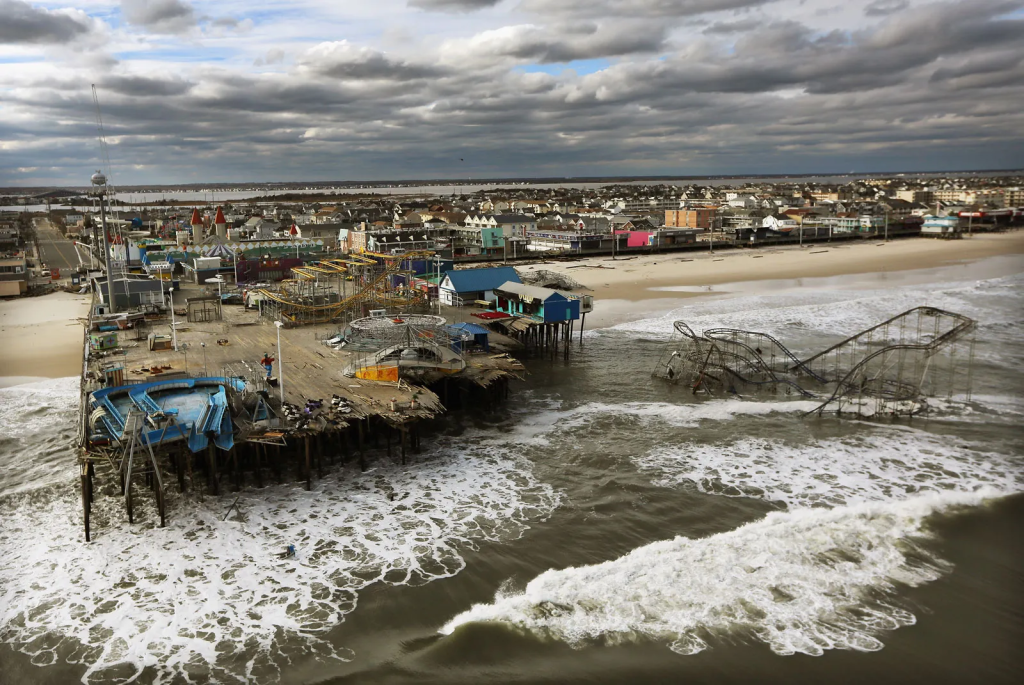Reading Abby Perkiss’s Hurricane Sandy on New Jersey’s Forgotten Shore alongside The Oral History Manual by Barbara Sommer and Mary Kay Quinlan and Donald Ritchie’s Doing Oral History has made me think deeply about the delicate intersections of memory, trauma, and ethics in oral history work. I was especially struck by the fact that Perkiss and her students began interviewing residents of New Jersey’s Bayshore only a few months after Hurricane Sandy—while people were still displaced, still negotiating insurance claims, and still trying to make sense of what had happened.
That immediacy makes Hurricane Sandy unlike any oral history project I’ve encountered so far. Usually, oral historians record memories long after events have passed (as in Swing Shift, nearly half a century after WWII), when time has softened the edges of experience and narrative coherence (or reconstruction or influence) has started to take shape. Perkiss’s project, by contrast, captures stories that were still unfolding. The narrators were not reflecting from a distance; they were speaking from inside the disaster.
This raises difficult and fascinating ethical questions. Is it too soon to ask survivors to relive painful experiences when the losses are still fresh? How do we ensure informed consent when participants are grieving, exhausted, or overwhelmed by bureaucratic systems? Sommer and Quinlan’s “life cycle” model of oral history emphasizes careful preparation, emotional safety, and respect for narrators’ boundaries. Their guidelines are designed precisely for situations like this—when an interview has the potential not only to document trauma but to retrigger it.
I found myself reading Perkiss’s work through the lens of my own prior professional experience interviewing and examining witnesses who had recently survived traumatic events—sometimes weeks, days, or even hours before our first interview. Those conversations required an intense mix of empathy, patience, and ethical restraint, and frankly, they inflicted an unhealthy dose of vicarious trauma, too. I had to earn trust, create space for emotion, and still maintain enough structure to do my job responsibly and ethically – trial work is, after all, a “truth-seeking” function (my notion of “truth” has certainly been redefined after nearly eight years removed from trial work). I recognize that same balance in oral history practice. Perkiss and her students weren’t “investigating,” but they were doing something similarly delicate: listening to people in the midst of pain, asking them to give shape to experiences that might still feel ungraspable to them and unrelatable to those who hadn’t been through the same.
Sommer and Quinlan, as well as Ritchie, both remind us that oral history isn’t just about collecting facts—it’s about building relationships. Ritchie, in particular, stresses that memory is never static or fully reliable, and that’s part of the point. Especially after trauma, memory becomes fluid: it shifts, contradicts itself, and sometimes resists coherence altogether. Perkiss’s narrators often speak in fragments or loops, moving between disbelief and determination. From a strictly factual perspective, these accounts might seem inconsistent. But from a human perspective, they’re profoundly truthful. They show how people experience and process trauma as it unfolds.
That’s what makes Perkiss’s project so ethically and emotionally compelling. The interviews were conducted not by outsiders parachuting in, but by students from the same state—people who shared a sense of loss, vulnerability, and commitment to documenting what mainstream media largely ignored and how marginalized certain Sandy survivors became in the wake of the storm. In that sense, the Sandy project feels less like extraction and more like collective witnessing. It preserves stories that might otherwise have been lost or never made visible, while also giving residents the chance to define their own narratives.
As I read, I kept returning to Ritchie’s idea that oral historians must balance empathy with professionalism. They are not therapists, but they are custodians of deeply personal truths. The simple act of being listened to—of having one’s story recorded with care and respect—can itself be a kind of validation, even a step toward healing. I’ve seen versions of that dynamic myself, sitting across from witnesses who just needed someone to hear them. Oral history, like testimony, can transform private pain into public acknowledgment, if not understanding.
These readings have also challenged me to reconsider what “accuracy” means in oral history. When trauma is fresh, memory is unstable—but instability doesn’t make it unreliable. Instead, it reveals the emotional truth of lived experience. Oral history’s task isn’t to correct that instability but to document it—to show how people remember, reinterpret, and assign meaning to events in the moment.
Ultimately, I see these three works as part of a continuum. Sommer and Quinlan offer the structure—the ethical scaffolding that keeps oral history safe and sustainable. Ritchie brings in the human side—the craft of listening and the humility of interpretation. And Perkiss shows what happens when those principles are tested in the real world, amid loss and uncertainty. Together, they remind me that oral history is both an ethical responsibility and an act of empathy. It requires structure and sensitivity, rigor and compassion.
When I think about Perkiss and her students recording those interviews in the cold winter months after Sandy, I see oral history not just as documentation but as a form of care—an attempt to hold space for stories before they harden into history. And that, to me, is one of the most powerful acts there can be of ethics and empathy.
